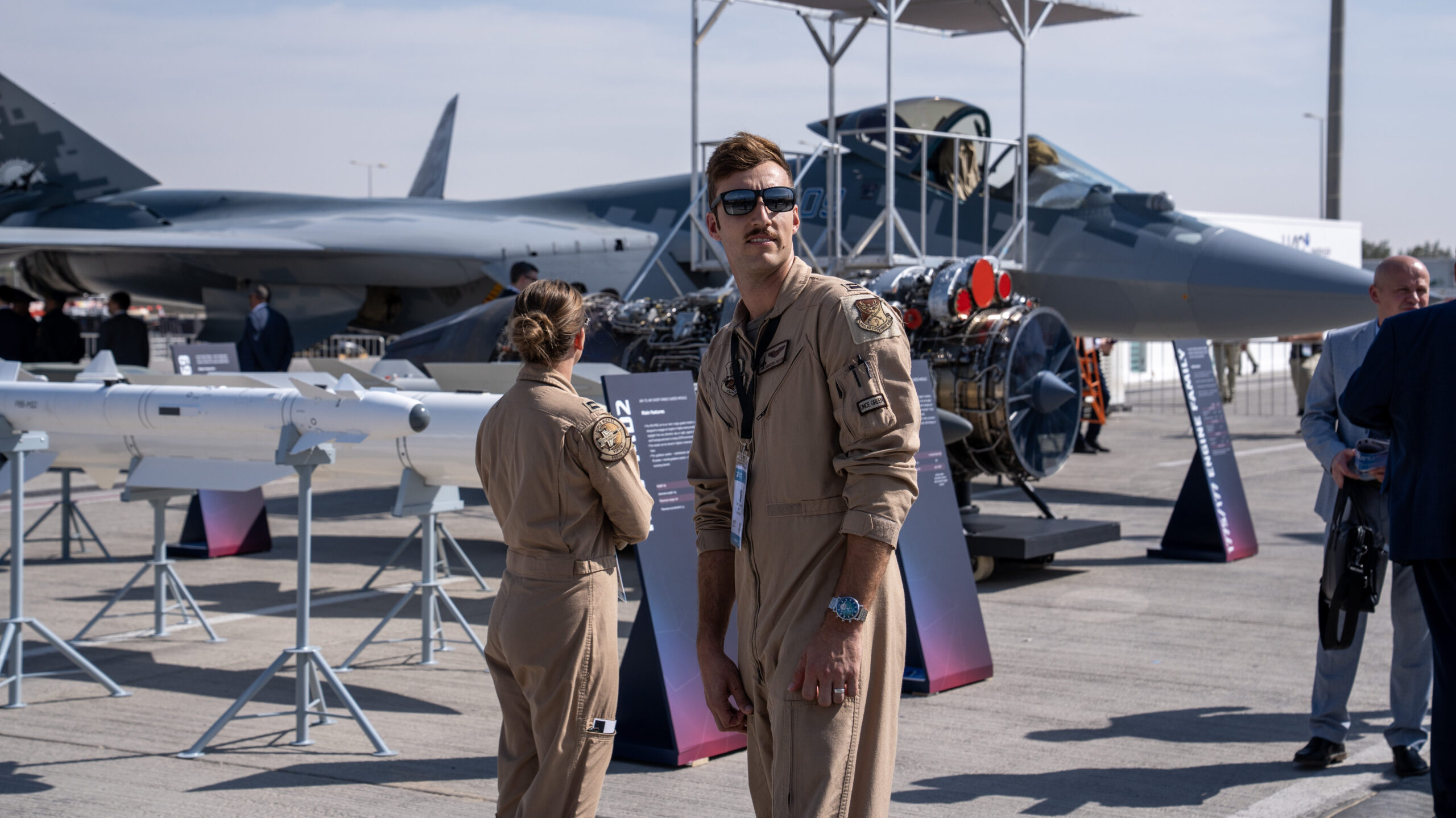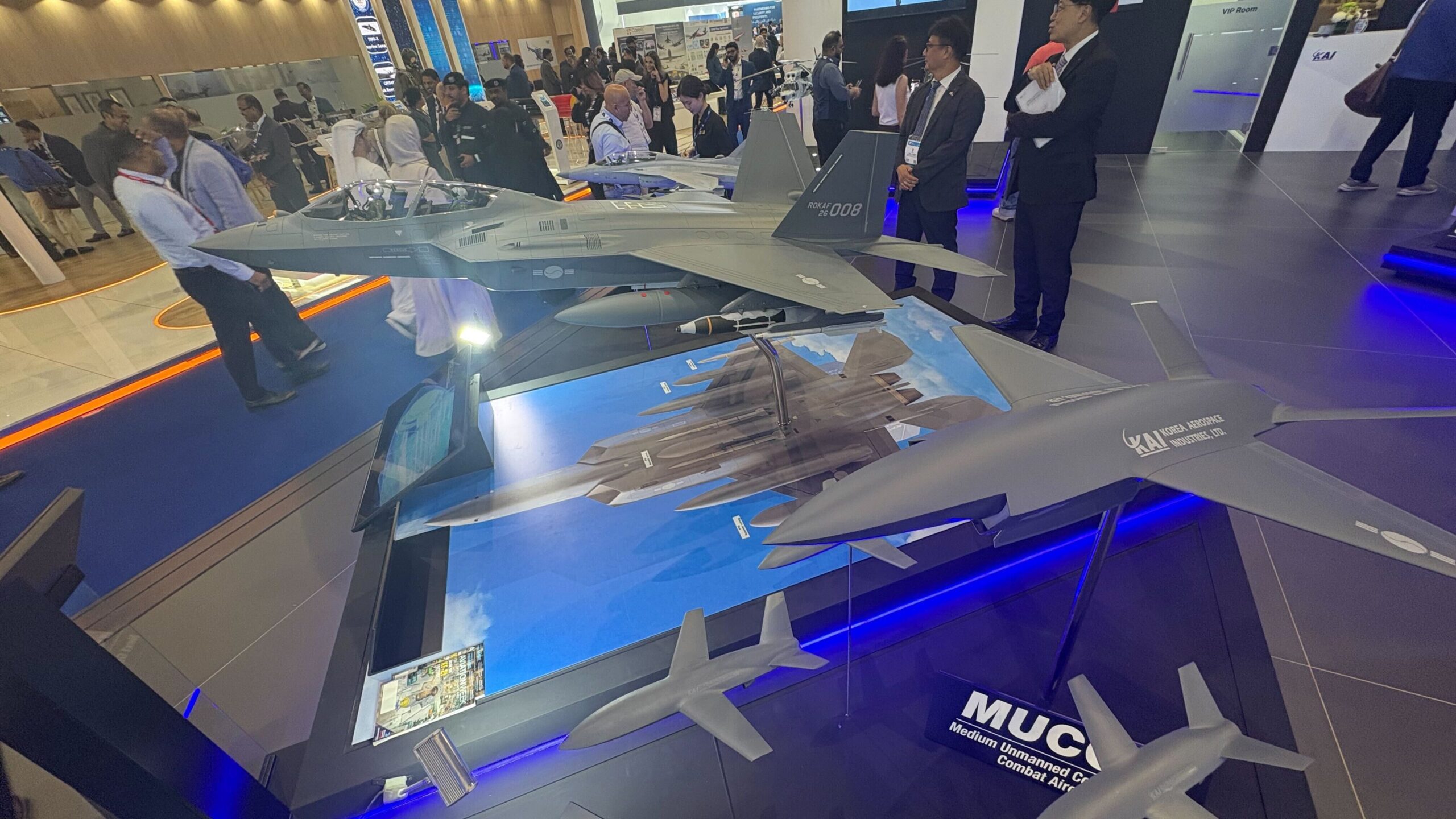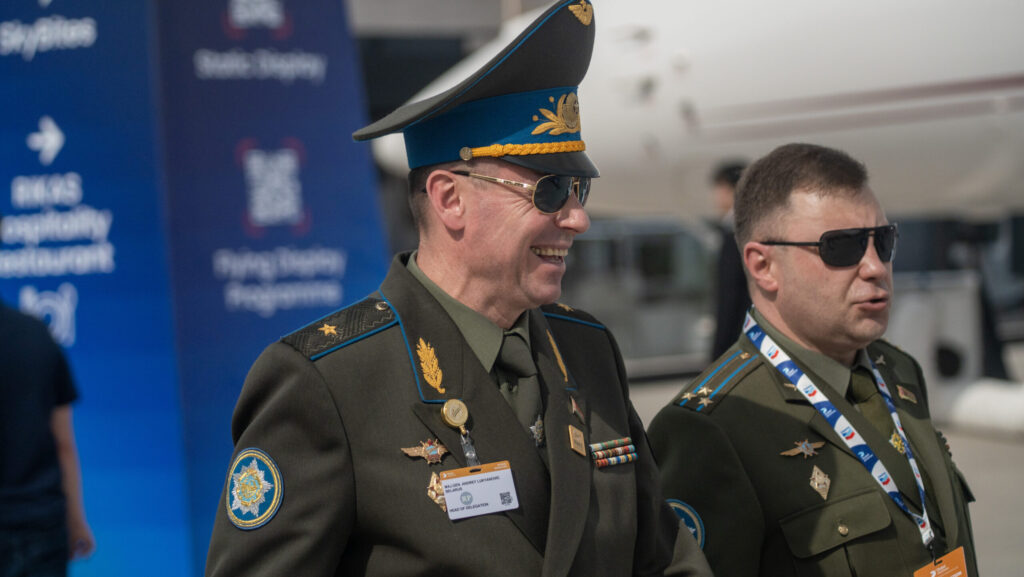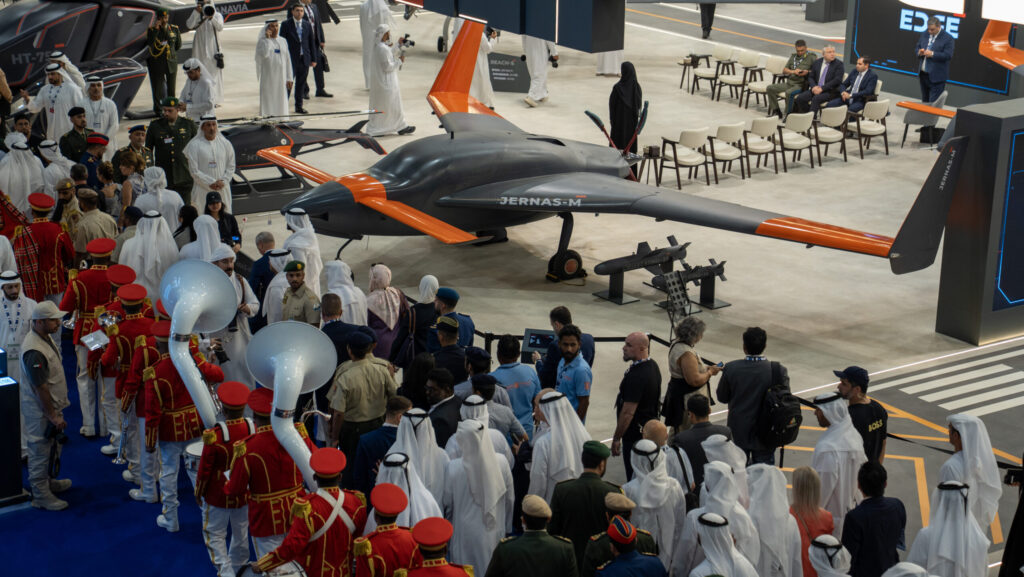Douglas A. Macgregor's Blog, page 4
November 18, 2025
F-35, tank sales part of new US-Saudi Strategic Defense Agreement
WASHINGTON — As part of a newly signed Strategic Defense Agreement between the US and Saudi Arabia, Washington has greenlit the sale of F-35 fighters and 300 Abrams tanks to the Middle East ally, the White House announced this evening.
“The SDA is a win for the America First agenda, making it easier for U.S. defense firms to operate in Saudi Arabia, securing new burden-sharing funds from the Saudi Arabia to defray U.S. costs, and affirming that the Kingdom views the United States as its primary strategic partner,” the White House wrote in a statement.
As part of the deal, Riyadh will purchase an unspecified number of F-35 fighters — a long-sought commitment from the Kingdom and a major boost to the Lockheed Martin-produced jet. The kingdom will also purchase “nearly” 300 Abrams tanks “enabling Saudi Arabia to build up its own defense capabilities and safeguarding hundreds of American jobs,” the White House added.
While not announced, other weapon sales may be part of the agreement as well. A top executive from General Atomics told Breaking Defense today that his company is in talks to sell up to 130 MQ-9Bs in addition to 200 Gambit loyal wingman drones to the Saudis.
Details on the F-35 will be closely scrutinized, as the US has pledged to maintain Israel’s Qualitative Military Edge — effectively, making sure Israel has better kit than its neighbors — in the region. The F-35I, which Israel has used operationally in recent years, is believed to have special sensors on board.
Asked about the QME, US President Donald Trump said in the Oval Office today that “When you look at the F-35, and you’re asking me is it the same, I think it’s going to be pretty similar, yeah.
“This is a great ally, and Israel’s a great ally, and I know they’d like you to get planes of reduced caliber. I don’t think that makes you too happy,” Trump said, directing his comments to Saudi Arabia’s Crown Prince Mohammed bin Salman. “We‘re looking at that exactly right now, but as far as I’m concerned, I think they are both at the level where they should get top of the line.”
The announcement of the deal followed that high-profile meeting today between Trump and the crown prince, on what is MBS’s first official visit to the US since the CIA found that Saudi agents killed Washington Post columnist Jamal Khashoggi in Istanbul. While MBS is the kingdom’s de facto ruler, this week’s red-carpet visit is not an official head of state event since King Salman holds that post.
While details from the ongoing visit and ensuing deals are still emerging, MBS announced he is pushing a May pledge to invest $600 billion in various US industries towards the $1 trillion mark.
“Today and tomorrow, we will announce that we are going to increase that $600 billion to almost $1 trillion for investment, real investment and real opportunity, by details in many areas, and the agreement that we are signing today in many areas, in technology, AI, in materials, magnet, etc, that will create a lot of investment opportunities,” MBS said in the Oval Office.
In addition to signing the SDA, the White House said the two leaders also inked a Joint Declaration on the Completion of Negotiations on Civil Nuclear Energy Cooperation, a Critical Minerals Framework and an AI Memorandum of Understanding.
The two countries have been hammering out a defense pact to deepen military and intelligence ties for some time. In April 2024, for example, then-US Secretary of State Anthony Blinken announced that a new defense pact between the two countries was “potentially very close to completion.” However, the question of Saudi normalization with Israel has proven to be a sticky wicket in any such agreement.
That issue seems to remain one to be worked out: MBS today seemed to hold off on Trump’s bid for Saudi Arabia to normalize diplomatic relations with Israel by signing onto the Abraham Accords, initially signed in 2020 by Israel, the United Arab Emirates, Bahrain and Morocco.
In the Oval Office this afternoon, MBS said that while he is still interested in signing on — a move opening up avenues for cross coordination of military capabilities like air defense weapons — doing so is contingent on a two-state solution for the Israeli–Palestinian conflict.
“We want, also, to be sure that we secure a clear path of two-state solution,” he added.
For his part, Trump has been pushing for Riyadh to sign on, reupping his comments during a late October interview on 60 Minutes. “I think we will have a solution. I don’t know if it’s gonna be two-state. That’s gonna be up to Israel and other people, and me,” Trump said. “But look, the main thing is you could’ve never had any kind of a deal if you had a nuclear Iran. And you essentially had a nuclear Iran. And I blasted the hell out of ’em.”
Dubai Airshow Day 2: Hot sun, cool planes
As the Dubai Airshow continued into its second day, attendees got the chance to see aircraft they might not otherwise encounter, like Russia’s Su-57 stealth fighter and China’s CH-9 drone. Stay tuned for more news and multimedia coverage of the airshow throughout the week.
 US troops check out the Su-57 stealth fighter in the Russian section of the 2025 Dubai Airshow. (Daniel Woolfolk/Breaking Defense)
US troops check out the Su-57 stealth fighter in the Russian section of the 2025 Dubai Airshow. (Daniel Woolfolk/Breaking Defense) General Atomics shows its full-scale YFQ-42A Collaborative Combat Aircraft model at the 2025 Dubai Airshow. (Agnes Helou/Breaking Defense)
General Atomics shows its full-scale YFQ-42A Collaborative Combat Aircraft model at the 2025 Dubai Airshow. (Agnes Helou/Breaking Defense) A Korea Aerospace Industries KF-21 model alongside drone wingmen. (Daniel Woolfolk/Breaking Defense)
A Korea Aerospace Industries KF-21 model alongside drone wingmen. (Daniel Woolfolk/Breaking Defense) The ELT/568-POD escort jammer from ELT Group. (Daniel Woolfolk/Breaking Defense)
The ELT/568-POD escort jammer from ELT Group. (Daniel Woolfolk/Breaking Defense) China Aerospace Science and Technology Corporation’s CH-9 drone sits on display at the 2025 Dubai Airshow. (Daniel Woolfolk/Breaking Defense)
China Aerospace Science and Technology Corporation’s CH-9 drone sits on display at the 2025 Dubai Airshow. (Daniel Woolfolk/Breaking Defense) What airshow wouldn’t be complete without bagpiping police? (Daniel Woolfolk/Breaking Defense)
What airshow wouldn’t be complete without bagpiping police? (Daniel Woolfolk/Breaking Defense)
F-35s for Saudi Arabia and Russians in the desert: Day 2 of the Dubai Airshow
While the Breaking Defense team in Dubai was asleep, US President Donald Trump said he’s looking to sell the F-35 to Saudi Arabia. How did that affect the second day of the airshow — and what did Russian industry reps have to say about it? Michael Marrow and Agnes Helou bring you the latest from Dubai.
And you can find more coverage from the Dubai Airshow here.
hbspt.forms.create({ portalId: '2097098', formId: 'ae1fdb21-cd2a-487c-af72-518741c62968', target: '#hubspot-form-ae1fdb21-cd2a-487c-af72-518741c62968', });DIU seeks microreactors from industry as Army IDs bases for nuclear power
WASHINGTON — The plan to put small nuclear reactors on Army bases took two steps forward today as the Defense Innovation Unit released a solicitation for commercially-made “advanced nuclear power technologies” and the Army picked out nine sites where the tech could eventually be deployed.
The moves amount to the first significant updates to the Army program since it was unveiled last month at the annual AUSA conference. The program is a joint effort with the Department of Energy that aims to stand up commercial nuclear microreactors at domestic military bases over the next few years. Army Secretary Dan Driscoll and Energy Secretary Chris Wright said last month that nuclear energy is the potential future for American energy independence.
“If you think about our engagement in a conflict in the Indo-Pacific, it is not going to be like a war we have had in the last 40 or 50 years,” Driscoll said at the time. “We’re going to need to be able to access power like we have never needed it before.”
The service has signed Memorandum of Agreement with the DIU for its Commercial Solutions Opening (CSO) process and Other Transaction Authority (OTA) to eventually award vendors for the Janus Program. With this came an initial Area of Interest (AOI) posting from the DIU and Army today.
In the AOI, the two organizations said they are looking for commercial vendors to demonstrate microreactors that incorporate nuclear fuel that is enriched to 20 percent or less with Uranium-235 and is “legal for defense purposes.” The microreactors should also, among other qualifications, be capable of producing electrical power in the range of kilowatt-level up to 20 megawatts-electric, or up to 60 megawatt-thermal.
After the initial solutions are presented, the DIU and Army will award companies who will then proceed to make their own “first of a kind” (FOAK) and “second of a kind” (SOAK) microreactor power plant prototypes. The organizations are looking for multiple solutions from a variety of vendors, the AOI said. Initial responses to the AOI are due on Dec. 15.
“Vendor solutions submitted under the AOI are highly encouraged to use the FOAK and SOAK approach in their proposals, and discuss the path from SOAK to Nth-of-a-kind production. Solutions may utilize the operating life of both the FOAK and SOAK MPPs [microreactor power plants] in series to reach the 30-year lifetime power generation, assuming continuity of power across the 30-year period,” the posting read.
Meanwhile, an Army news release today the service announced nine sites for “initial deployment” for the microreactors:
Fort Benning, Ga. Fort Bragg. N.C. Fort Campbell. Ky. Fort Drum. N.Y Fort Hood, TexasFort Wainwright, Alaska Holston Army Ammunition Plant, Tenn. Joint Base Lewis-McChord, Wash. Redstone Arsenal, Ala.“While the final number and location for these microreactors on Army installations will be determined as part of the acquisition process, the Army is committed to maximizing the number of sites based on technical feasibility, site suitability, and available resources,” the release noted.
Jeff Waksman, principal deputy assistant secretary of the Army for installations, energy and environment, told reporters last month that the Army will not force a nuclear reactor on a community that is against having one.
“There’s gonna be a long period of local engagement and local discussion. … I think as long as we have that discussion, as long as we have a clear face to the project, and we’re clearly engaging with local communities, then I think there’s going to be a lot of appetite for it,” he said at the time. “Now, if the local communities decide they don’t want it, then we won’t go there. We’re not here to impose on any local communities.”
NDAA on track for mid-December: Rep. Wittman
WASHINGTON — The House and Senate are very close to a compromise deal on the fiscal 2026 National Defense Authorization Act (NDAA), with the policy bill on track for a floor vote in the next few weeks, Rep. Rob Wittman, R-Va., said today.
“The NDAA is making great progress. I think we are just about finished with all the issues involving HASC [the House Armed Services Committee] and SASC [Senate Armed Services Committee]. The other issues remaining to be resolved are issues having to do with other committee jurisdictions, and those mostly are relegated to the Senate, so they’re trying to work through those particular issues.” he told the State of Defense Business Acquisition Summit sponsored by Defense One.
“I think that those will hopefully be done by the end of the week, and then the bill will be in its final form. It should be on the floor at the beginning of the second week of December,” predicted Wittman, who is a HASC member.
One of the things that the NDAA is focused on, he explained, is defense acquisition reform — an issue that Defense Secretary Pete Hegseth has now put at the top of his agenda.
“I think there’s some pretty important parts of what’s in this bill. We’ve done some things to really open the aperture for private equity investments through the Office of Strategic Capital to leverage more private dollars into the defense … R&D [research and development] stream,” Wittman said. “I think that’s going to be key.”
Another important change included in the bill would implement the Pentagon’s proposal to consolidate the current system of program-specific acquisition executives into fewer Portfolio Acquisition Executives (PAE) accountable for many interrelated programs, with the ability to shift cash among weapon systems based on performance or schedule considerations, he said.
This includes extending the posting period for the PAEs from the traditional three years to six years, which will provide “more certainty” and allow those officials to be more “willing to take some risks,” Wittman said.
He cautioned, however, that in order to foster a more risk-tolerant defense acquisition culture at the Pentagon, Congress has to also change how it oversees program management.
“It has to start in Congress. I mean, we can’t lecture and say, ‘take risk,’ and then the first time there’s a failure, we call somebody up on Capitol Hill and bang the table and holler and scream and go, ‘how did you do this? How could this happen’?” Wittman said. “Because guess what? That behavior will stop at a heartbeat when somebody goes, ‘you know what? I watched them drill this PAE up on Capitol Hill. I’m not going to do that, so I’m not going to take any risks.'”
Congress should establish, fund new quantum tech initiative to beat China: Panel
WASHINGTON — Congress should set in motion a sweeping initiative to ensure that the United States can stay ahead of China’s rapid development of dual-use quantum technologies and artificial intelligence, urges the US-China Economic and Security Review Commission in its latest annual report.
“Whoever leads in quantum (and artificial intelligence) will control the encryption of the digital economy; enable breakthroughs in materials, energy, and medicine; and gain asymmetric and likely persistent advantage in intelligence and targeting,” the commission’s 2025 report, presented to Congress today, says.
“It is imperative that the United States treat quantum not as a research silo but as a mission-critical national capability—and act accordingly,” the report adds.
The commission’s 2025 report finds that China is continuing to “pour significant resources into over-the-horizon technologies such as artificial intelligence and quantum computing that have dual-use purposes and could accelerate China’s military and intelligence capabilities.”
Thus, the group recommends that lawmakers establish by 2030 a “quantum first” goal to “focus on quantum computational advantage in three mission-critical domains—cryptography, drug discovery, and materials science.” The commission argues that the 2030 timeline “is essential to ensure the United States achieves quantum leadership before any adversary can leverage these capabilities against American interests.”
In tandem, Congress should provide “significant funding” for US quantum development, “focused on scalable quantum computing modalities, secure communications, and post-quantum cryptography,” as well as to new “workforce development” programs.
This includes the creation of a “Quantum Software Engineering Institute (QSEI) focused on developing the software foundations for scalable, secure, and interoperable quantum computing,” modeled on the National Artificial Intelligence Research Institutes and National Manufacturing Institutes. “[T]he QSEI would ensure that U.S. quantum hardware is matched by world-class software capabilities, enabling early operational advantage across science, industry, and defense,” the report says.
The bipartisan US-China Commission was established by Congress in 2000 to “investigate, and report to Congress on the national security implications of the bilateral trade and economic relationship between the United States and the People’s Republic of China,” according to the commission website.
Stronger Export Controls, Congressional OversightMore broadly, the US-China Commission is calling for series of measures to substantially beef up US export controls on key technologies, such as semiconductors.
The report’s number one recommendation is that Congress mandate a new, interagency organization to “address the evolving national security challenges” being created by China’s “systematic and persistent evasion” of US export controls and sanctions.
This “unified economic statecraft entity” should at a minimum include: the Commerce Department’s Bureau of Industry and Security (BIS), the Treasury Department’s Office of Foreign Assets Control, the Office of Export Control Cooperation at the State Department’s Bureau of International Security and Nonproliferation, and the Defense Department’s Defense Technology Security Administration, the report elaborates. Further, it should be tightly integrated with the Intelligence Community to allow “enhanced access to real-time intelligence on evasion networks.”
“[T]his is not something that we’d snap our fingers and all of a sudden have an entity ready to go in in trade negotiations with the current administration. It’s something that’s going to take time to implement and to integrate,” explained Commissioner Leland Miller, who is the CEO of the China Beige Book that provides data on the Chinese economy to companies and investors.
“The idea, though, is that the piecemeal approach to economic sanctions and to export controls has meant that there hasn’t been coordination. … [D]ifferent agencies have sort of prioritized and and operated separately,” he told reporters on Monday. “So, I think one of the reasons that we have pushed on this, and have elevated this to our top recommendation, is that there is a need at this point for these really important national security priorities to be put forward as more than a throw in in a trade negotiation.”
In addition, the commission urges lawmakers to strengthen the ability of BIS “to manage strategic competition with China in fast-moving technology sectors, such as leading-edge semiconductors used in artificial intelligence (AI) applications, and increase congressional oversight.”
This includes two key changes to US export controls on AI-enabling chips. First, Congress should direct BIS to change the “presumption of denial” for licenses to export to China those microchips now on Commerce’s export control list to a more stringent “policy of denial” — meaning that exports of certain chips would be barred if deemed potentially harmful to US national security.
The second change would call for Congress to force BIS to set up a system to “rent” rather than sell “advanced chips” by “mandating that any advanced chips above a certain threshold that are not designated as prohibited for export be accessible exclusively via the cloud.” Under the new system, exporters would be required as part of their licenses to vet their customers and report any “suspicious” activities.
SpaceOver the past few years the commission has outsourced reports on China’s rapidly expanding space capabilities, and the new report doubles down on those concerns.
“China is pursuing an aggressive long-term, whole-of-government campaign to expand its space capabilities across military, commercial, and civil domains with the explicit intent of surpassing the United States. These rapid advances in space pose an escalating threat to U.S. national security, intensify U.S.-China strategic competition for international partnerships, and undermine the ability of U.S. commercial firms to compete internationally,” the report finds.
In the military arena, the report focuses in on the PLA’s pursuit of counterspace capabilities designed to “degrade, damage, or destroy” US satellites “that provide the backbone” the military’s command and control network and targeting systems. The commissioners stress that over the past decade China has maintained an “aggressive schedule” of satellite launches for its own military use, as well as strengthen its ability to keep tabs on, and in the case of conflict target, US forces, especially those in the Indo-Pacific.
“Beijing’s investment in counterspace systems — including direct-ascent anti-satellite weapons and co-orbital interference platforms — illustrates its strategy of blinding and disorienting U.S. forces in the opening phase of a conflict,” the report states.
The commissioners thus recommend that Congress take actions “to preserve and strengthen U.S. primacy in the critical space domain as China pursues sweeping advancements across military, commercial, and civil space sectors.”
These include moving to “increase or reallocate appropriations” for the Space Force “to levels necessary to achieve space control and establish space superiority against China’s rapidly expanding space and counterspace capabilities.” Lawmakers also should “direct” DoD to improve the Space Force’s capacity for wargaming, modeling, simulation and training.
In addition, the report urges Congress to hold oversight hearings designed “to ensure the United States maintains primacy in the space domain by identifying investments in cutting-edge space technologies and assessing China’s space capabilities and threats to U.S. space industrial base capacity.”
November 17, 2025
Drones and dignitaries mark day 1 of the Dubai Airshow
Breaking Defense is on the ground at the Dubai Airshow! Day 1 delivered big news: UAE President Sheikh Mohamed bin Zayed toured the floor, the US Air Force advanced its drone wingman vision with an F-22 fighter controlling an MQ-20 Avenger, Embraer signaled a key production shift, and Lockheed pushed converting manned helicopters to its autonomous Black Hawk.
Breaking Defense breaks all that down — plus, what’s ahead. Stay tuned for daily recap videos and catch up on all the news on our Dubai Airshow page.
hbspt.forms.create({ portalId: '2097098', formId: 'ae1fdb21-cd2a-487c-af72-518741c62968', target: '#hubspot-form-ae1fdb21-cd2a-487c-af72-518741c62968', });On the tarmac at the Dubai Airshow
Breaking Defense has a team on the ground at the Dubai Airshow. Here’s a look at some of what they’ve seen on the opening day of the conference.
 The Ilyushin Il-76 transport aircraft looms large on the tarmac in Dubai. (Breaking Defense/Daniel Woolfolk)
The Ilyushin Il-76 transport aircraft looms large on the tarmac in Dubai. (Breaking Defense/Daniel Woolfolk) The tower overlooks everything at the 2025 Dubai Airshow. (Breaking Defense/Daniel Woolfolk)
The tower overlooks everything at the 2025 Dubai Airshow. (Breaking Defense/Daniel Woolfolk) A Russian Pantsir-SMD-E missile system on display at this year’s Dubai Airshow. (Breaking Defense/Daniel Woolfolk)
A Russian Pantsir-SMD-E missile system on display at this year’s Dubai Airshow. (Breaking Defense/Daniel Woolfolk) A up-close look at Russia’s Pantsir-SMD-E missile system. (Breaking Defense/Daniel Woolfolk)
A up-close look at Russia’s Pantsir-SMD-E missile system. (Breaking Defense/Daniel Woolfolk) A Maj. Gen. from Belarus enjoys the 2025 Dubai Airshow. (Breaking Defense/Daniel Woolfolk)
A Maj. Gen. from Belarus enjoys the 2025 Dubai Airshow. (Breaking Defense/Daniel Woolfolk) A crowd of people gather around EDGE Group’s booth, where the company is showing off its Jernas-M compact medium altitude long endurance drone. (Breaking Defense/Daniel Woolfolk)
A crowd of people gather around EDGE Group’s booth, where the company is showing off its Jernas-M compact medium altitude long endurance drone. (Breaking Defense/Daniel Woolfolk)
Golden Dome faces challenges of size, scope and scale from every angle
The announcement of the Golden Dome missile defense system to protect the United States from missile attacks represented a major shift in defense priorities for the US military — and presents myriad challenges when trying to protect a country the size of the US.
The model is Israel’s Iron Dome, but that system covers a relatively small area and mostly protects against traditional ballistic missile attacks. Golden Dome will cover a much larger area, and must be able to counter intercontinental ballistic missiles (ICBMs), cruise missiles and hypersonic missiles. All of those requirements add complexity, engineering challenges and cost considerations.
The US has announced $175 billion to fund the program, and has placed it under the control of Space Force Gen. Michael Guetlein. Guetlein will have oversight and acquisition authority for Golden Dome, which signals a different approach than the norm, says John Plumb, former Assistant Secretary of Defense for Space Policy.
“Not just a new initiative and a system, but also new acquisition authorities vested in the new position that Gen. Guetlein’s now in, which is interesting, and signals an intent to move faster than normal acquisition processes,” Plumb said as part of a recent Breaking Defense roundtable discussion on Golden Dome.
Creating this nationwide shield will require overcoming a number of engineering and technical obstacles, as well as the potential response from Russia and China to what they may view as destabilizing technology.
The technical challenges of Golden Dome
ICBM defense, which is what the US has traditionally focused on, is a relatively straightforward problem. ICBM launches can be detected and flight paths can be tracked, and those flight paths are fixed.
But Golden Dome will have to meet other challenges. Cruise missiles can take unpredictable flight paths and even loiter over targets, and hypersonic missiles offer speed and flexibility in maneuvering that makes them much harder to identify, track and intercept.
That challenge is defined as the “absentee ratio,” which is the number of interceptors needed to ensure that one is always available to strike a target. That ratio becomes more complex to figure out as new capabilities make targets harder to track, says Tom Karako, director of the Missile Defense Project at CSIS.
“The biggest problem is the absentee ratio, at least in terms of the Brilliant Pebble kind of architectures,” says Karako. “Most of your space-based interceptors, especially if they’re in a stable orbit of 300, 400 kilometers, or potentially higher, they’re out of range, right? Their divert cone to be able to deorbit quickly and get that (ICBM) that’s rising is very limited.
Golden Dome: Tackling the myths and rumors around America’s new missile shield [VIDEO]
“There’s many, many interceptors that are not able to get there. The fact that you can group your shots with a next generation interceptor, NGI, or a GBI (ground-based interceptor), is one of the reasons we’ve gone that way, against the limited, rogue threats that we’ve got.”
For cruise missiles, the flexibility in their launch platforms makes them harder to combat. Cruise missiles can be launched from aircraft or submarines, and do not have to follow a fixed flight plan. A missile launched from an aircraft or a submarine can be on target faster than an ICBM, and can fly low enough to escape detection by many radar systems.
“It has nothing to do with a high-powered ICBM boosting out of a landmass on the other side of the Pacific,” said Plumb. “Helping solve that problem, putting more pressure on the adversary, terribly fascinating. But that does not exist in any real way right now, outside of point defense with Patriots, for example.”
To combat these new threats, Golden Dome will require an extensive detection and tracking infrastructure, with space-based surveillance being a critical component to detect and track launches from anywhere. Satellites will play a major role in surveillance, but they cannot hover in one place, so the movement of both satellites and the Earth will affect surveillance.
In low-Earth orbit, a satellite is moving at roughly 7.8 kilometers per second, which is fast enough to orbit the Earth in about two hours. But when the satellite completes an orbit, the Earth’s rotation means that the satellite is not over the same spot that it was when it started its orbit.
“Let’s say you want coverage over the Korean Peninsula. (For) North Korea, you know where there’s a rough launch site and you say, ‘I’m going to cover this,’” said Plumb. “How many satellites do you need to have? Something is there, it’s basically overhead for about six minutes. The number goes up exponentially in order to cover that one location, to say nothing of the math, of trying to hit something coming up [over] the top.”
Building the surveillance infrastructure will create cost and logistical challenges, including replacing satellites on a regular basis to provide the necessary coverage.
“If the satellites the commercial industry is developing are good for 5 to 10 years, and you want a 20-year life cycle, you’re going to replace them two to four times,” says Plumb. “That all costs.”
How Russia and China will respond
Any major military initiative will be watched closely by Russia and China, and those countries will – if they are not already – develop ways to respond. They will likely view Golden Dome as potentially destabilizing, and that potentially creates a new arms race.
“It wasn’t that many years ago when Russia was saying that a single Patriot launcher in Poland with no missiles on it was provocative and destabilizing,” said Karako.
Golden Dome could be viewed as a way around the idea of mutually assured destruction, which is a delicate balance between nuclear powers. If Russia and China feel that card is off the table, they may begin exploring ways – not necessarily nuclear – to create an advantage in the event of a major conflict that allows them to circumvent Golden Dome’s capabilities. Those strategies may be kinetic – e.g., attacking satellites in space – or they may be cyber and electronic warfare driven, such as trying to disrupt communications or surveillance capability.
Ultimately, building Golden Dome will likely lead to both diplomatic and military responses as Russia and China try to keep pace with what the US hopes to achieve.
“If China and Russia are not a little bit irritated by what we’re doing on Golden Dome,” said Karako, “I’m going to be very disappointed, because that means that we’re not doing enough of the right things to counter the actual threats and to impose costs.”
US will sell F-35 to Saudi Arabia: Trump
DUBAI AIRSHOW and WASHINGTON — US President Donald Trump today announced that he expects to sell Saudi Arabia the F-35 Joint Strike Fighter, a long-sought commitment from the Kingdom and a major boost to the Lockheed Martin-produced jet.
“They want to buy them, they’ve been a great ally. … I will say that we will be doing that, we’ll be selling F-35s,” Trump said in the Oval Office Monday in response to a question about the potential sale. His comments come ahead of a visit to the White House by Saudi Crown Prince Mohammed bin Salman.
Trump did not expand on whether that deal would be completed during the visit by bin Salman, which reportedly may also involve some sort of security agreement between Saudi Arabia and the US. Trump’s comments Monday were a stronger version of a statement he gave at the end of last week indicating the F-35 was on the table for this visit.
“They wanna buy a lot of jets,” Trump reportedly said, adding “I’m looking at that. They’ve asked me to look at it. They want to buy a lot of ’35’s — but they want to buy actually more than that, fighter jets.”
The Kingdom of Saudi Arabia has been keen to join the F-35 club since 2017, the same year that the United Arab Emirates voiced its intent to procure the US-built, fifth-generation fighter jet. The UAE actually inked a deal for the jet in the waning days of the Trump administration, but that deal was frozen indefinitely by the Biden administration over concerns about the prevalence of Chinese technology in the UAE’s networks.
But neither Gulf power has given up on the dream of owning the F-35. Now, it seems the Saudis may be lined up to achieve their goal.
At a media briefing at the Dubai Air Show in the UAE, Lockhee’s Steve Sheehy, vice president of Aeronautics Strategy & Business Development, declined to delve into details of the potential sale to Riyadh.
“President Trump made the announcement,” he said. “We appreciate his supporting of the F-35 program. But this is right now still in a government-to-government position. That’s what we see at the moment.”
UPDATED 11/18/2025 at 7:16am ET to include comments from the Lockheed official.
Douglas A. Macgregor's Blog
- Douglas A. Macgregor's profile
- 28 followers



